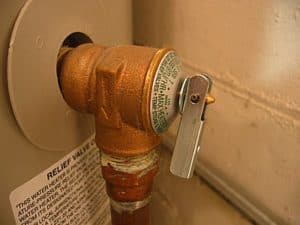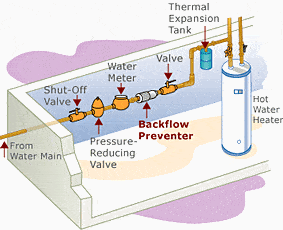Table of Contents
Every Water Heater has a Temperature Pressure Relief Valve (TPR valve).
It is a safety valve which releases water (and thus relieves pressure) if either the temperature or pressure in the tank gets too high. A Pressure Relief Valve is very important because Water heaters can become bombs if the pressure is too high and these valves fail to work.
Leaking Temperature Pressure Relief Valve
When a TPR valve suddenly starts leaking on your water heater, and there hasn’t been any plumbing renovation work done recently, the most likely cause is a faulty valve. As the valves age they occasionally begin to leak. Over time water may build up deposits in the valve that begin to interfere with it closing. Or, it could be particles from the tank get stuck in the seat holding it partly open. There’s a lever on the valve to open it deliberately. It’s advisable to open it periodically to be sure it’s working properly.
Another reason for a TPR valve to leak water is high pressure in the water heater tank. This is usually caused by one of two things: high main water pressure or a back flow prevention/check valve.
Backflow Valves
Houses built or renovated in the past 10-20 years generally have a back flow prevention valve in the water supply line if they are up to code regulation. Back flow valves only allow water to go in one direction. Building codes now require these valves so that once water enters a home it cannot move backward into the water supply system and it introduces a new problem. As a water heater heats the water it expands, making a greater volume of water and the extra water needs somewhere to go. If all the faucets in a home are closed the water becomes trapped. Before backflow valves, water was simply pushed back out of the house into the main supply. Since the backflow valve prevents this, the extra water has no place to go. The pressure builds in the tank until it exceeds the TPR valve set point (about 120 psi) and water comes out the TPR discharge tube.
It is necessary to install an expansion tank on the cold water line between the backflow valve and the water heater. These tanks give the extra water a place to go. If a backflow valve is installed on a home, then an expansion tank should have been installed but if the valve is leaking it may be the expansion tank has failed.
Main Pressure May Be Too High
If the main water supply pressure coming into a home is too high this can cause the pressure to exceed the TPR valve set point. Uniform Plumbing Code calls for water to be delivered to homes for domestic use at between 50 to 70 psi, and supply lines as well as appliances are designed to withstand up to 80 pounds per square inch.
Water pressure regulators installed in a home reduce the amount of pressure delivered by the water district to between 50 and 70 psi. Over time the rubber and metal parts in these regulators can fail causing water pressure to the home to increase and puts a strain on valves, hoses and appliances they were not designed to withstand. Installing a pressure regulator on the incoming water line will alleviate the problem. The main problem is, this pressure regulator behaves like a backflow valve and will not allow water to go backward through it so an expansion tank is necessary.
If you suspect the pressure in your water heater is too high you can buy a water pressure gauge to check it or call a plumber. If the pressure does not increase as the water is heated, but the pressure reads above 80 psi all the time, the supply pressure is too high.
Carter’s My Plumber has Backflow Certification
Carter’s My Plumber has certified Licensed Plumbers who are trained to install pressure regulators, and pressure tanks. Call 317-859-9999 to schedule an appointment today!





